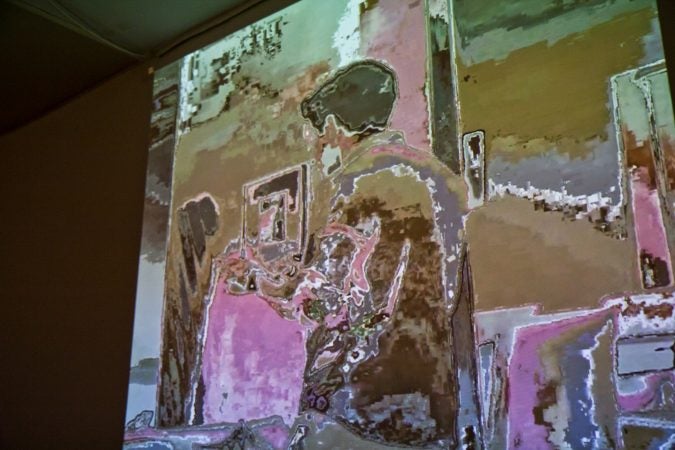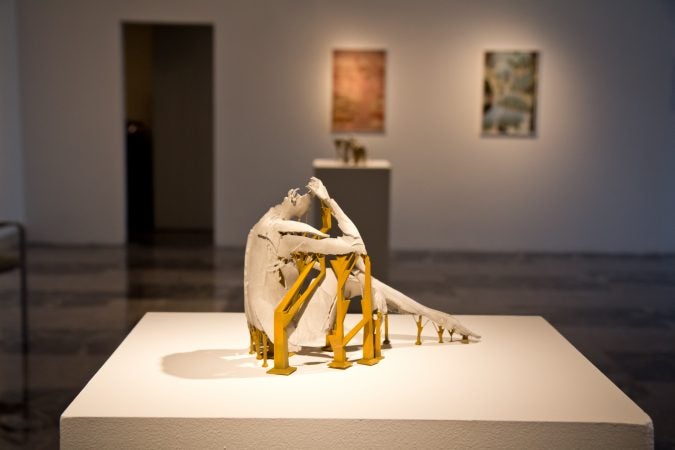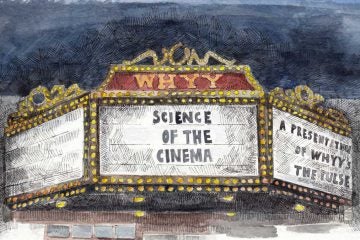Philly exhibit explores idea of technology as 21st-century phantom limb
The idea is that technology has distorted how we view ourselves and society — and yet, it is an inescapable part of us.
Listen 1:47-

Danielle Ezzo is a featured artist and curator of Phantom Limb at the Esther Klein Gallery. (Kimberly Paynter/WHYY)
-

Sophie Kahn is a featured artist of Phantom Limb at the Esther Klein Gallery. (Kimberly Paynter/WHYY)
-

Sculpture work by artist Sophie Kahn in Phantom Limb at the Esther Klein Gallery. (Kimberly Paynter/WHYY)
-

Projected work by artist Zach Nader in Phantom Limb at the Esther Klein Gallery. (Kimberly Paynter/WHYY)
-

Sculpture work by artist Sophie Kahn in Phantom Limb at the Esther Klein Gallery. (Kimberly Paynter/WHYY)
Doctors use the term “phantom limb” to describe a patient’s sensations that an amputated or missing limb is still a part of the body. The University City Science Center’s Esther Klein Gallery is also using the term as the name of its latest exhibit, which explores the role of technology for 21st-century artists.
The idea is that technology has distorted how we view ourselves and society — and yet, it is an inescapable part of us.
The exhibit features work by three Brooklyn-based artists, all of whom use some sort of digital technology to create their art. But instead of simply relying on technology alone, they have manipulated their work in some way.
A 3D-printed sculpture of a distorted female body, for instance, has been buffed and painted to look like fragmented stone. The pixels in a photograph of an embracing couple have been skewed to make it look more like a painting.
Featured artist Danielle Ezzo, who is also the curator, uses digital photography and digital editing software to explore the human body. Using her hands to shape technology, Ezzo said, she and the other artists are able to show how technology and human lives have merged. She sees technology as just another tool in an artist’s toolbox to convey a certain message.
“I think it’s a way to empower artists,” she said. “At least for myself, it feels empowering just to have more tools to get closer to what my internal vision is.”
Sophie Kahn, another featured artist, makes 3-D-printed sculptures. She scans human bodies, but the scanners can’t properly read the bodies, so the data she sends to the 3-D printer are damaged and glitchy. What results is like a 3-D motion blur.
“It’s like the body has been fed into the digital realm, and then fed out again, but in an altered form,” she said.
Her work focuses on the female body and the way it is treated almost as a project — something that is always under revision to achieve some vision of perfection. She manipulates the materials by hand to convey that message, but she said technology has allowed her to create work she otherwise wouldn’t be able to make.
“I think there’s a lot of concern in the crafts about ‘de-skilling,’ and that digital is taking over from traditional tools,” Kahn said. “For me, it’s actually been the opposite. Digital was my path to learning how to sculpt and learning how to make molds and how to learn physical sculpture tools.”
Zach Nader, the third artist featured in the exhibit, works with digital photography, reworking existing photographs into something new and modern. His work has appeared nationally and internationally, including a recent monthlong nightly video installation in Times Square.
The exhibit is open Monday through Saturday until May 25.
WHYY is your source for fact-based, in-depth journalism and information. As a nonprofit organization, we rely on financial support from readers like you. Please give today.



